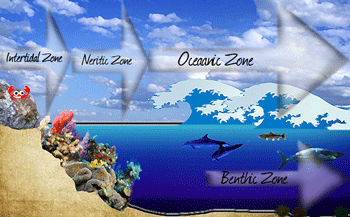Four Major Oceanic Zones
Studying Oceanic Zones
Oceanic zones were created by oceanographers to make it easier to study individual areas of the oceans. They were also designed to study animals living in specific areas of the oceans.
Major vertical zones of the ocean begin at sea level and end at the deepest points in the ocean.
Horizontal zones are another set of zones in the ocean. Starting at the seashore they cover the ocean floor. These zones include the seashore, continental shelf, continental slope, deep ocean floor, and ocean trenches.

Four zones in the oceans where animals live. NOAA
Horizontal Zones
The coastal zone is the area in the ocean where the land between low tide and high tide. The ocean floor is exposed in this zone during low tide and covered up when it is high tide. Many different animals have learned to adapt to this habitat where there are long periods during the day they are exposed to the air or seawater. Animals that survive in these conditions include sea stars, sea urchins and some species of coral.
Tidepools
Tide pools allow many organisms to thrive in these areas including abalone, sea anemones, seaweed, chitons, crabs, mussels, and sea cucumbers. All of these animals that have adapted to living in wet and dry conditions on the seashore. Many live in very narrow bands especially on rocky shores where wave actions allows them to thrive only in these areas.


Click for More Information and to Order
Pelagic zone
The Pelagic Zone begins seaward of the low-tide mark and is always covered by
water. There are two subdivisions of this zone: Neritic zone and Oceanic zone.
Neritic Zone
The Neritic zone lies
above the continental shelf. It extends from the low-tide mark outward from the
seashore to where the depth of the water reaches 200 meters (656 feet). This
water is lit by sunlight and relatively shallow. The majority of sea life lives
in this zone because it has well-oxygenated water, low pressure, and a fairly
stable temperature.
Free floating zooplankton live in this area and are the base of the food pyramid that supports the great fishing areas in the ocean. Coastal fish live in this area and do not inhabit the ocean beyond the continental shelves.
Oceanic zone
The Oceanic zone extends from the edge of the continental shelf over the
continental slope to the ocean floor beyond. It begins where the water is over
200 meter (656 feet) deep. This zone contains deep trenches, volcanoes, and
ocean basins. Vertical zones are used in the open ocean based on the amount of
sunlight that reaches the area and the pressures exerted on animal living
there.
Vertical zones
The vertical zones in the ocean include the epipelagic, mesopelagic and bathypelagic zones. The zones are based on the amount of light that penetrates the ocean waters.
Epipelagic zone
The epipelagic zone is
also called the sunlit zone because it receives enough sunlight to support
photosynthesis. Temperature of the water ranges from 40 degrees to -3 degrees
Centigrade.
Mesopelagic zone
The mesopelagic zone lies beneath the sunlit zone and is often called the
twilight zone. The temperature range is fairly stable in this part of the
ocean. Water temperature is between 4 degrees and 5 degrees Centigrade. The
pressure increase as the depth increases. It reaches up to 1,470 pounds per
square inch.
Scientists up until the mid-20th century did not believe animals could survive at these depths because of the pressure. Today we know some animals thrive in these conditions and whales can dive from the surface deep into the ocean where their prey on colossal squid that live in these pressures.
Bathypelagic zone
The bathypelagic zone is also called the midnight zone because no light
penetrates the area and the water is near freezing. In the 1970s a research
vessel discovered black smokers where a community of animals were thriving
including giant tubeworms. They do not require sunlight to live but live on
bacteria that grows around the thermal vents that create the black smokers.
Benthic Zone
The benthic zone is ocean floor all the way from the low-tide mark outward to the deepest trenches on the ocean floor. Animals have been found living in all areas of the ocean. Most plant and animal life lives on the continental shelf that is relatively shallow and sunlight penetrates the water to support plant life. Many different types of plants and animals live in the zone and are often attached to the rocks.
KIDS FUN Science Bookstore
Check out Myrna Martin's award winning textbooks, e-books, videos and rock sets. The Kids Fun Science Bookstore covers a wide range of earth science topics. Click here to browse.










